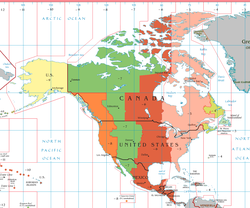Atlantic Standard Time Zone - Simple English Wikipedia, the free encyclopedia

The Atlantic Standard Time Zone (AST) is a geographic region that keeps time by subtracting four hours from Greenwich Mean Time (GMT), resulting in GMT-4 (UTC-4). The clock time in this zone is based on the mean solar time of the 60th degree meridian west of the Greenwich Observatory.
The Canadian provinces of New Brunswick, Nova Scotia and Prince Edward Island keep time by subtracting four hours from UTC. So does Bermuda, an island territory in the North Atlantic. In the summer, both places use daylight saving time. They keep Atlantic Daylight Time (ADT) (UTC-3) in the summer.
Other parts of the world that keep time by subtracting four hours from UTC include: many Caribbean islands, including Puerto Rico, the U.S. Virgin Islands, and several South American countries, such as Paraguay, Chile, Bolivia, and parts of Brazil. Venezuela used AST until December 9, 2007, when it switched to UTC-4:30, but switched back to AST on May 1, 2016, at 2:30 a.m. local time.[1]
References
[change | change source]- ↑ "Clocks to Go Forward Permanently in Venezuela". Time and Date. April 18, 2016. Retrieved April 19, 2016.
Other websites
[change | change source]- World time zone map Archived 2015-12-24 at the Wayback Machine
- U.S. time zone map Archived 2009-02-15 at the Wayback Machine
- History of U.S. time zones and UTC conversion Archived 2004-10-12 at the Wayback Machine
- Canada time zone map
- Time zones for major world cities
- Official times across Canada
- The official U.S. time for the Atlantic Time Zone (no DST) Archived 2014-06-03 at the Wayback Machine


 French
French Deutsch
Deutsch